How do you know if your students are practicing properly at home? Far too many students “piano practice” means play through everything assigned…maybe a few times…and that’s it.
That’s certainly not what our piano practice as teachers looks like. We spend our time problem solving, drilling trouble spots, analysing the score and testing our memory.
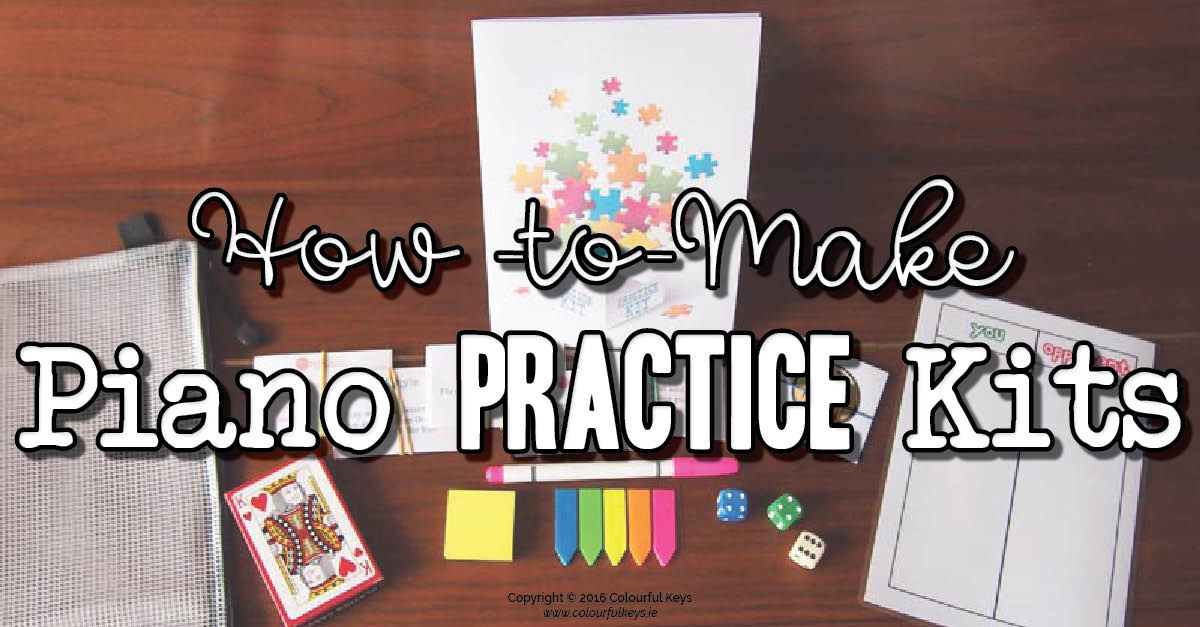
So how can you get your students to replicate this in their own piano practice time? A recent post on Facebook in Piano Teacher Central prompted me to start thinking about piano practice kits again. I’ve seen this idea in varying forms in a few different places and decided it was finally time to act.
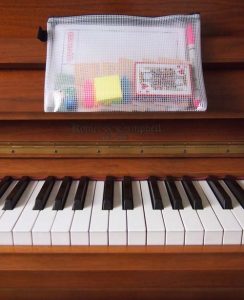
I spent a few weeks putting together a generous supply of piano practice kits for my students. This was a considerable investment of my time, but if it makes even half my students practice smarter, it will be worth it.
If you want to try something a little bit simpler while you’re getting these kits together – go grab these practice step stickers. This is a quick win that you don’t want to miss!
So, what’s inside the Piano Practice Kit?
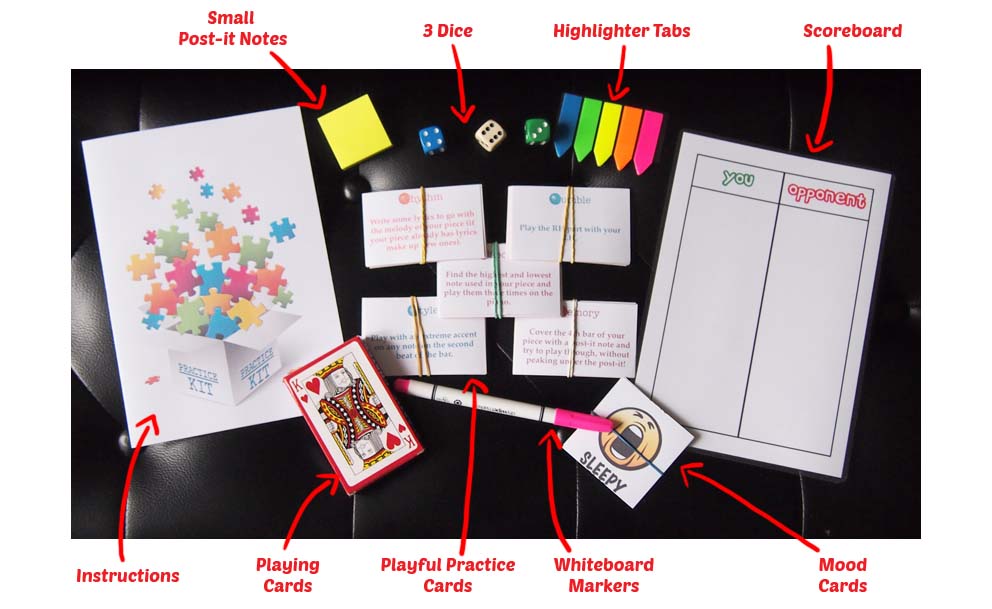
It took me a while to source all these elements economically, but I got there in the end!
Inside the practice kit my students will find:
- Instructions with details of all the practice games (download in the box below)
- Laminated Score Board (download in the box below)
- Whiteboard marker (fine point ones like these are best)
- Emoticon Cards (download in the box below)
- Playful Practice Cards (available in the Colourful Keys store)
- Highlighter tabs (I bought mine locally, but these are similar)
- Three dice (these look like a good deal)
- Small square post-it (about the right size to cover one measure)

Subscribe to updates and get the Practice Kit
Enter your details to subscribe to the newsletter for piano teachers with information, tips and offers.
I hate spam as much as you do! I'll only send you information that's directly relevant to music teachers and you can unsubscribe at any time.
Vibrant Music Teaching members, you can access this resource inside the VMT library. Not a member yet? Find out more about becoming a member here.
Emoticon Cards

When piano students are engaged, they’re also more focussed. Asking kids to perform a piece like they’re angry might seem counterproductive, but a real performer also knows how to act. Students that can transform a ragtime march and make it say what they want, are able to feel the music and understand expression.
Playful Practice Cards

Playful Practice cards help piano students to practice smarter, more thoughtfully, and more creatively by assigning tasks and asking questions to get students really thinking about what they are doing during their practice time.
The cards are in five different categories: Jumble, Rhythm, Style, Theory and Memory. With prompts like; “Play your right hand part with your left hand” and “Improvise with your right hand while playing the left hand part as written”, these cards will ensure no student is just phoning it in.
Dice Game
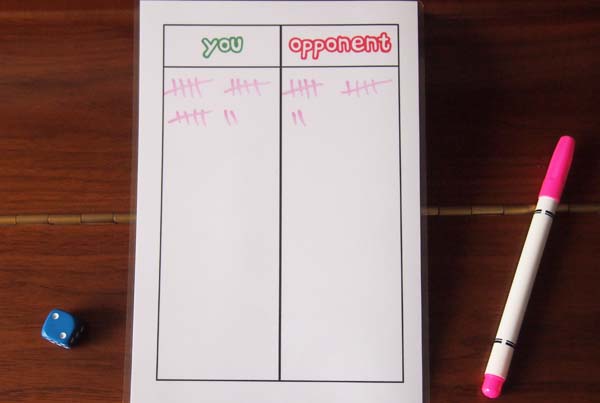
You can play this game with 1 or 2 dice. Choose a section of a piece you are working on. Roll the dice, and then play the section. If you play it correctly add the number on the dice to your score on the scoreboard (use a whiteboard marker), if you made a mistake the score goes to your opponent.
Repeat this process you or your opponent reaches 30 points, if your opponent wins, play another practice game with that section.
3-in-a-Row

Something about having tokens to move just makes playing a section three times successfully so much more palatable to students. Each time they play a section correctly they move one die to the right hand side, but a mistake means they need to put one die back on the left hand side.
Note: I only chose dice for this game because it was the cheapest option I could think of, you can use any token in place of the dice.
Chop Suey
This is modified from an idea that someone posted on Facebook, although I changed the rules a little.
Divide the piece into 10 sections (mark the numbers in pencil on the music). Take out the playing cards, shuffle and draw the top card. Play that section of the piece (ace is 1).
– JACK = play first section
– QUEEN = play last section
– KING = play complete piece
Beat the Dealer
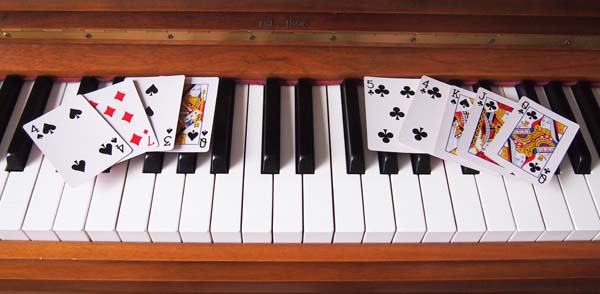
Deal three cards face up, and add up the total (jack, queen & king are all 11). Play your chosen section or piece. If you play it correctly, turn over a card for your “hand”. If you make a mistake, add another card to the “dealer’s hand”.
Continue until the total in your hand is greater than the dealer’s hand.

Subscribe to updates and get the Practice Kit
Enter your details to subscribe to the newsletter for piano teachers with information, tips and offers.
I hate spam as much as you do! I'll only send you information that's directly relevant to music teachers and you can unsubscribe at any time.
Vibrant Music Teaching members, you can access this resource inside the VMT library. Not a member yet? Find out more about becoming a member here.
Have you made practice kits for your studio?
What did you include? Did your students like them? What would you do differently than I did?

Your ideas are so creative…AND so practical and easy to put into use immediately with materials that are so accessible. Thank you so much for sharing your ideas.
Thank you Lavinia! I know how busy piano teachers are so I always aim to make resources that are simple and quick to put together 🙂
I agree with Lavinia! Thank you so much! I am grateful for your willingness to share your very creative ideas! They are a huge help!
Thank you Janie! Glad your enjoying the blog!
This is such an amazing resource! Thank you for sharing it with us!
Where did you get those cute little bags?
I got them at my local office supply store, these ones on amazon look very similar: https://amzn.to/1Xse80P
What fun for students. Great ideas. Thanks for sharing your talents.
You’re very welcome Leticia!
I love these! But I ordered a studio license for the practicing cards and can’t get them to download. I have a zip program but only an ipad computer. Help? Thank you!
Got it to work! Thanks!
Glad you got it sorted out Emily, let me know if you have any other issues.
I love the idea of starting students out with a practice kit. Making a practice is game is much more fun and rewarding. I’m excited to browse through your other creative piano teaching ideas!
Thanks Heidi! Glad you’re enjoying the resources!
I’m not sure I can jump into these for all of my students, but I think dividing out all the games into different packets and then letting my students check them out each week would also be so fun!! Thanks so much for sharing these fabulous ideas!
That sounds like a great plan Dori, let me know how it works out!
I love this idea and I am in the process of putting them together for each family. I have showed a couple of parents and a couple of students and they are really excited about it. If it gets 1 or 2 to practice more – I will be a happy camper! Do you have the post it notes and highlighter tabs in there for a reason or just because they could be used for something along the way?
They’re not strictly necessary Leslie. I use them for marking trouble spots, starting places and noting which game they should use for each piece. Just handy to have around. Hope your students love their kits!
Hi there,I found your youtube video on activities to teach preschoolers play the piano, and I love your creative ways with objects! I have a special needs 6 year old, cant read or write yet and would love to teach him this way! How can I find those activities?
Hi Vanessa, I think this post is what you’re looking for: https://colourfulkeys.ie/4-fun-ways-teach-preschoolers-keyboard-geography/
What are the small post-it notes for?
Mostly for marking sections, also just generally a useful tool to have around during piano practice. 🙂
Super cute ideas! How can I download the things “in the box below”? Nothing is letting me click it.
It’s fixed now thanks Morgan 🙂
Great idea!! Love to try these.
Your website is a land mine of good ideas. It has been so helpful. Thank you so much!
Aw, thank you Jackie!
Great ideas! Thank you! What do you use the small post-it notes for?
Covering up bars and noting which game they should play. 🙂
Hi Nicola! In the past I made these up for my students and charged $5 each for them…I think I broke even lol! Do you have your students bring these with them to lessons? I found that s few of them lost a lot of the stuff out of the bag. Do you charge for these? Also, do you show them how to play each game when you give it to them or just play one with them each week?
Just play and assign one game at a time – whichever is useful for your student at the time. Reinforce this at several lessons before adding another.
I don’t ask them to bring them to lessons, I prefer that they leave them on top of the piano at home, ready to go.
Hi! How do I get the downloads for the emoji cards, instruction cards, etc? I can’t seem to find the link. Subscribed the newsletter and received the practice stickers. 🙂 Thanks for the fabulous resources.
Did you fill in your details in the boxes on this page Irma?
I don’t see the download option for the emoticom cards. Is it in an obvious place or has it been removed?
It’s a big coral and orange box Jana. Do you not see that?
I LOVE this blog post Nicola! Your ideas are so creative!!
Just thought I’d let you know that I use clothespins in place of dice for the 3-in-a-row. They are cheap, fun to clip at the top of the book, and even involve a bit of finger dexterity exercising lol.
Great idea! 😀
Hi everyone! Thank you for sharing the lovely ideas, Nicola! Of course, I would definitely include learning music reading with the TunyStones App. It was invented to motivate kids to practice music reading (which is not easy at all with traditional methods…). Try it out!